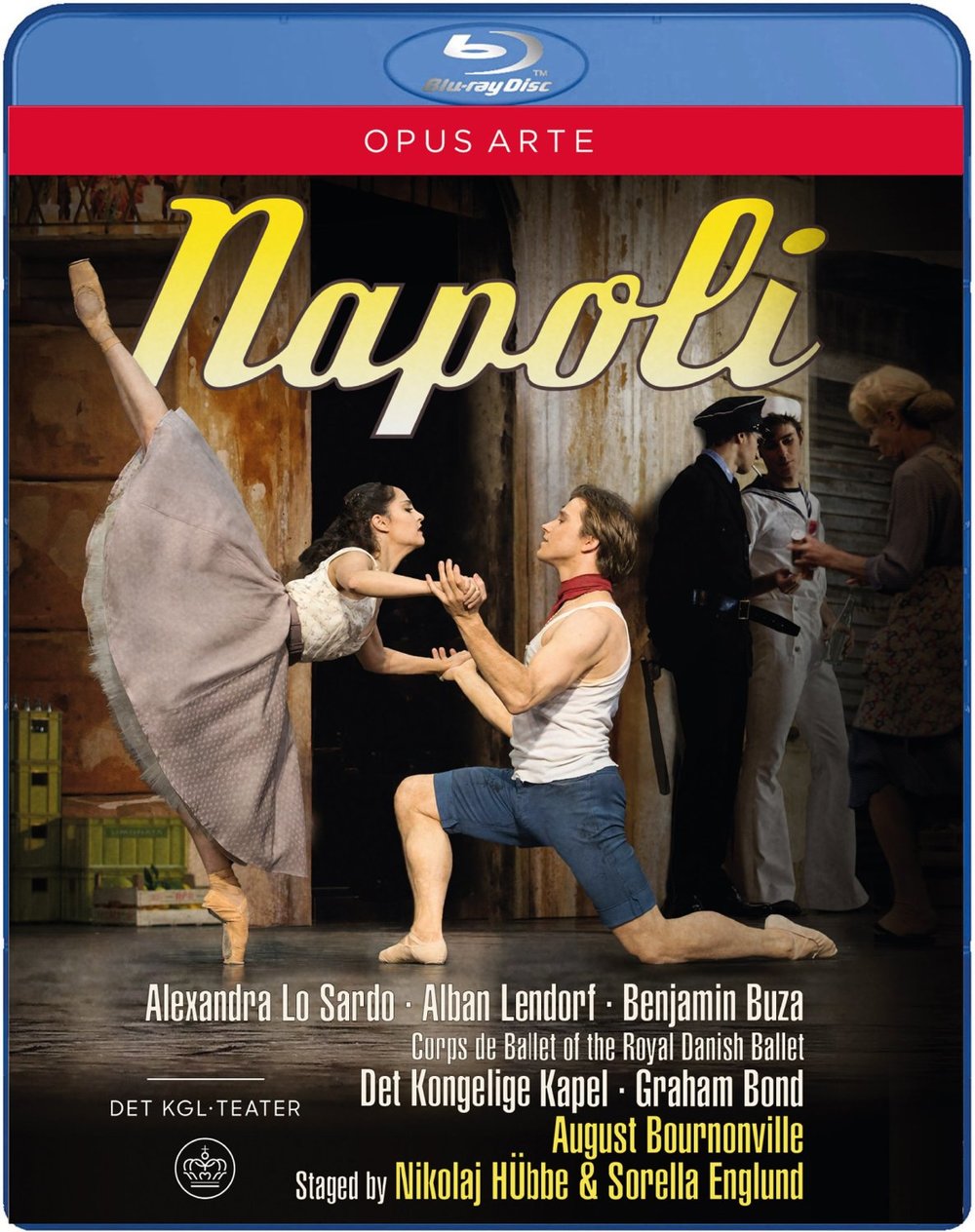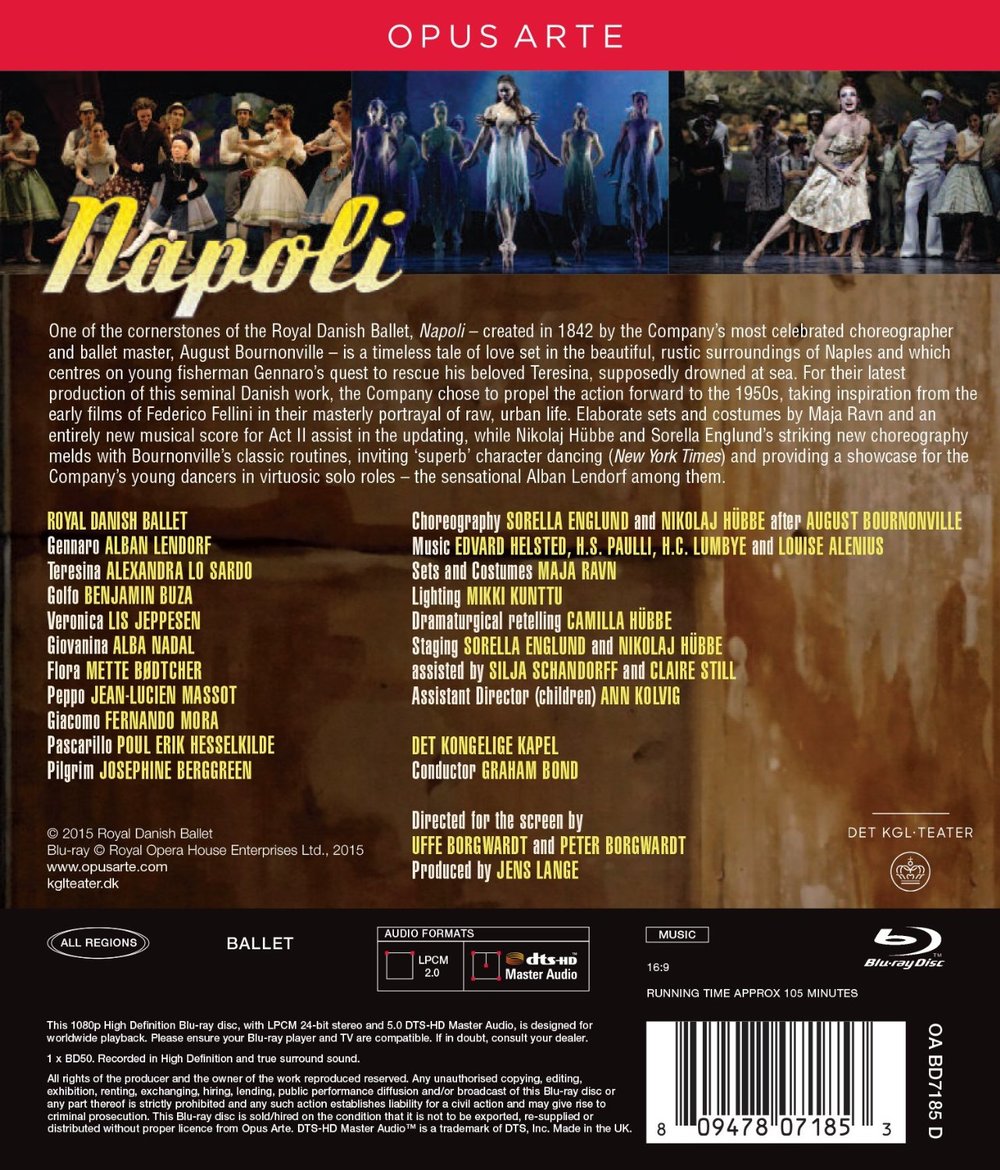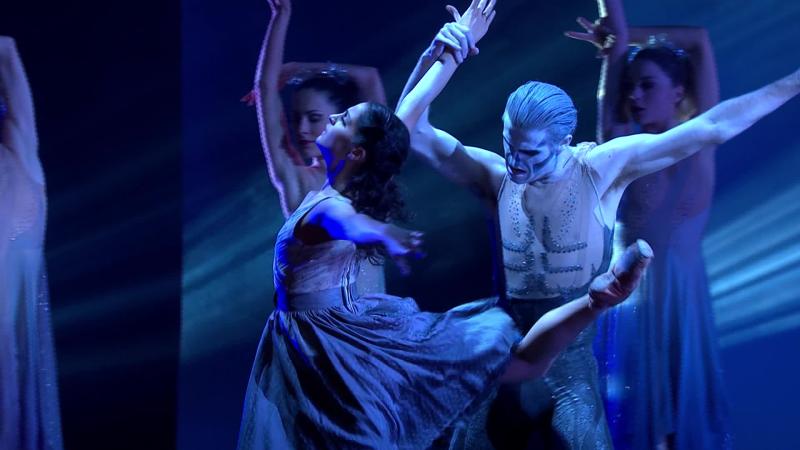

Napoli ballet to music by Edvard Helsted, H.S. Paulli, H.C. Lumbye, and Louise Alenius. Choreographed by Sorella Englund and Nikolaj Hübbe after August Bournonville. Stars Alban Lendorf (Gennaro), Alexandra Lo Sardo (Teresina), Benjamin Buza (Golfo), Lis Jeppesen (Veronica), Alba Nadal (Geovanina), Mette Bødtcher (Flora), Jean-Lucien Massot (Peppo), Fernando Mora (Giacomo), Poul Erik Hesselkilde (Pascarillo), Josephine Berggreen (Pilgrim), Magnus Christoffersen (Cyclist), Mogens Boesen (Carlino), Eva Bloborg (Carla, Guesthouse Owner), Cédric Lambrette (Fra Ambrosio), Maria Bernholdt (Prostitute), and Josee Bowman (Prostitute). Corps dancers include: Ulrik Birkkjaer, Carolina Baldwin, Marcin Kupinski, Gregory Dean, Holly Jean Dorger, Amy Watson, Susanne Grinder, Ide Praetorius, Christina Michanek, Amalie Adrian, and Jonathan Chmelensky. Graham Bond conducts Det Kongelige Kapel. Sets and costumes by Maja Ravn; lighting by Mikki Kunttu; dramaturgical retelling by Camilla Hübbe; staging by Sorella Englund and Nikolaj Hübbe assisted by Silja Schandorff and Claire Still; assistant direction of children by Ann Kolvig. Directed for TV by Uffe Borgwardt and Peter Borgwardt; produced by Jens Lange. Opus Arte includes a cheap keepcase booklet with typefonts so tiny and ugly that you may need a magnifying glass to read it. Released 2015, disc has 5.0 dts-HD Master Audio sound. Grade: B-
Bournonville premiered Napoli in Denmark in 1842, a few years before Marius Petipa began his fabled career in Russia. So Napoli is an old work. It's been a national treasure in dank, dark Denmark from the start because the staid Danes are attracted like moths to the Napoli flames of carefree, cheerful street life by day and hot-blooded romance by night. Here's the squalid little square next to the bay where the fishermen tie their boats:
Here's pretty Teresina (Alexandra Lo Sardo) and her boyfriend, the poor but handsome fisherman Gennaro (Alban Lendorf).
Gennaro is sweet and generous. But Teresina's mom, Veronica (Lis Jeppesen) isn't impressed by his meager earning capacity:
This video has many extreme close-ups which seem jarring to me when compared to most of the video images:
This is 1957 when all the poor teenage girls in the western world wore "A"-line skirts with crinolines. (A rich girl would wear a similar skirt with a poodle embroidered on it near the hem.):
There are many distinct characters living at the square whom you get to know well. Here's one of the two prostitutes. Actually, it's hard to make any gorgeous dancer in this corps look like a whore. The trick is to put her in fishnet hose with a hole the size of a dinner plate:
A cross-dressing street singer (Poul Erik Hesselkild). He mimes his song to a solo from a trumpet:
There's no privacy at the square. Teresina wants to go for a little boat ride. Gennaro warns that a storm is gathering. But who could refuse a smile like this. There's no way with this set to show the couple getting in a boat. If you don't know the story, it's easy to miss the significance of this brief conversation and you might be baffled by the rest of Act 1:
The storm scene is impressive. But what has happened to boat with Teresina and Gennaro? Fishermen dive into the bay. They rescue Gennaro, but there's no trace of Teresina. Nobody can console mom, and Gennaro is left alone thinking of suicide. But the mysterious pilgrim (Josephine Berggreen) reminds Gennaro that he wears Teresina's amulet around his neck. This will protect him if he dives to find Teresina in the Blue Grotto:
Golfo (Benjamin Buza) is Lord of the grotto surrounded by his harem of naiads:
Golfo begins the initiation of Teresina as a naiad:
H'm. Looks like the Rite of Spring. Soon Golfo will take Teresina as his next wife:
Gennaro enters the underworld. In the original version of Napoli, Gennaro's descent into the grotto was presented as religious miracle. This would not work 175 years later, and now he is only protected by his love and Teresina's amulet. Like Orpheus, he has his guitar to help lure Teresina back:
After a fight with Golfo, Gennaro and Teresina return to the realm of air:
Act 3 opens at the Shrine of the Mountain Virgin where all the neighbors have gone to a mourning service for Teresina. There Mom sees something that she firsts interprets as a vision of demons:
But gradually, everyone realises that Teresina is back alive! Mom consents that the couple may wed:
When my friends were getting married in 1957, I went to a lot of Presbyterian, Methodist, and Baptist weddings in rural North Carolina (USA). After a boring ceremony in a cold or hot church there was a reception for about 45 minutes at the church. You got a piece of cake and a plastic cup of some hideous "punch" based on a non-alcoholic fruit juice. We were too ignorant to even dream of what a real wedding party could be like. Maybe it was the same way with those dour, dolorous Danes. So Bournonville gives us, not just a series of divertissements, but a real Italian wedding party that goes on and on until nobody can dance anymore. And the couple gets a motor scooter to boot!
This plot is as thin as India paper. But still it manages to serve as a framework for the display of local color, frustrated romance, tragedy, eroticism, heroism, reconciliation, and celebration. The Danes have preserved the Bournonville style for 175 years, and the dancing is consistently fascinating. The dancers can also act. Acts 1 and 3 are performed to a pastiche of pleasant if unremarkable ballet music that's adequate to support the dancing. The Act 2 Blue Grotto music is all new and commissioned for this production. It's terrific with eerie strings, winds, and percussion passages supporting a fantastically spooky tuba part. The SQ is fine.
But there are serious issues with the dramaturgical retelling and video content. Act 1 seems to me to be noticeably hectic. There's too much going on in too little time and space in a frantic effort to dish out as much "local color" as conceivably possible. For example, there are in Act 1 no less than 13 different shots showing what the non-dancing prostitutes are doing. I don't need to be reminded 13 times that there are prostitutes in Naples.
But the real problem, which I see and all 3 acts, is hugely excessive churning of video content. Act 1 lasts 34 and 1/2 minutes and has, I count, 483 clips. Of these clips, only 53 show the whole stage and only about 6 of the whole-stage shots last as long as 10 seconds. 342 of the 483 clips (70%) only show (1) part of the active dancers, (2) parts of dancing bodies, or (3) extreme close-ups. The average video clip lasts only 4.38 seconds! Is this the fastest, most hyperactive video I've ever timed? As a checked on this, I looked through the HDVD ballet titles we have and concluded that the most fast-paced dance title I could recall was the Elite Syncopations piece by Kenneth Macmillan in which 12 different Dixieland jazz numbers are performed nonstop in about 34 minutes. The average clip in that video lasts about 9.1 seconds. In other words, subject video is more than twice as fast as any other dance video I can think of. I also ran the numbers on the Blue Grotto Act 2. Since this dancing takes place "underwater," you might expect the pace of video cuts would be slower than in Act 1. Well, Act 2 clocks in about the same as Act 1 at 4.8 seconds per clip.
The video was the responsibility of father and son team Peter and Uffe Borgtwardt. As best I can tell from the Internet, these gents have mostly movie experience. Force-feeding of rapid video clips may be a viable movie-making technique, but it's a poor approach to making a video of a ballet. In a ballet video, the most important goal should be to present each complete dance performance statement in a single clip using long-range views, or, if necessary, moderate panning or zooming in a short range view. The dancing line normally should not be broken except for some exceptionally good reason. Rapid fire clips violate the dance aesthetic. Another reason to avoid too many clips is to avoid overloading the brain of the spectator in the home theater. The spectator in the live theater sees the whole show a one clip! Each time the TV director allows a new clip, he requires the spectator to adjust to something new. Do this to him every 5 seconds and you risk exhausting your customer and being accused of sabotage.
End of sermon. Even with over-heated action on the boards, too many extreme close-ups, and the hyperactive TV direction, this is a reasonably enjoyable HDVD. And this is the only contemporary video of Napoli available. So the Hübbes and Borgtwardts give us a B- title. But, alas, they missed their chance to produce something precious (by doing less, not more).
OR


























